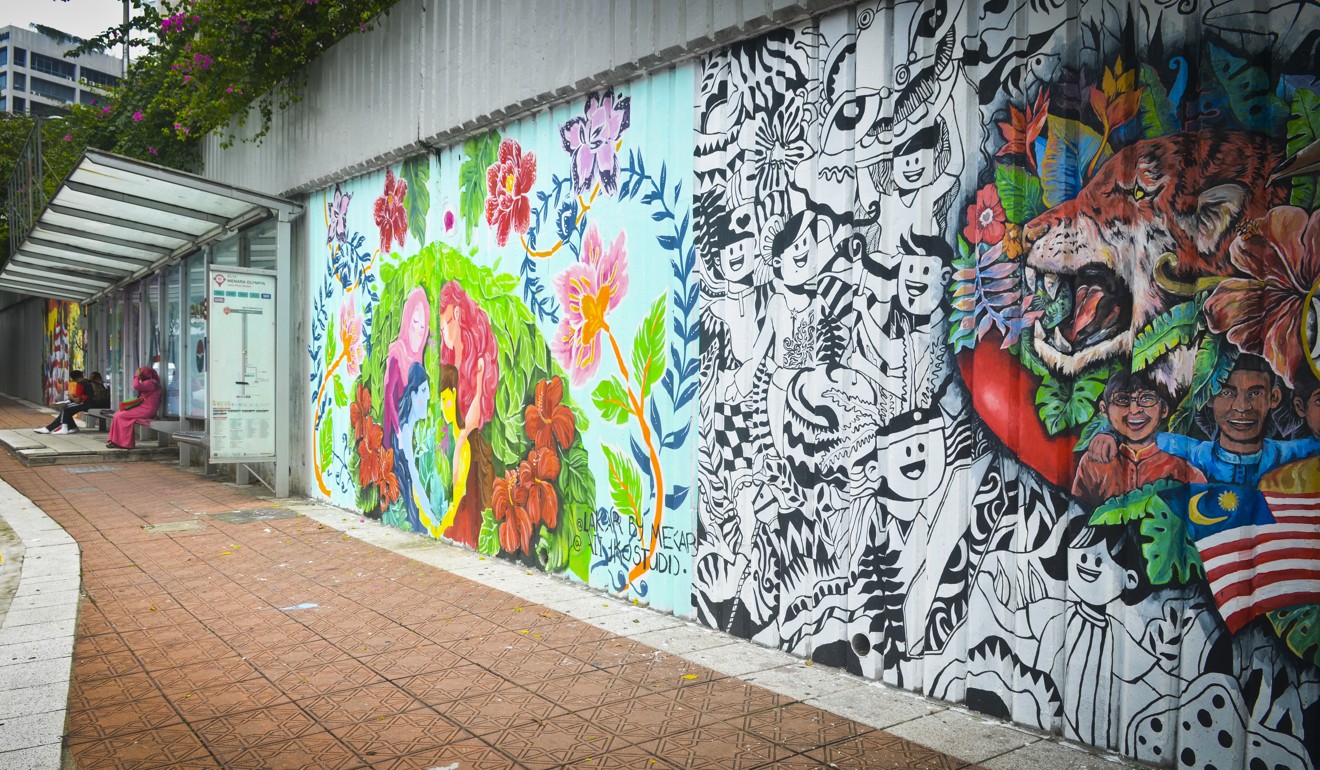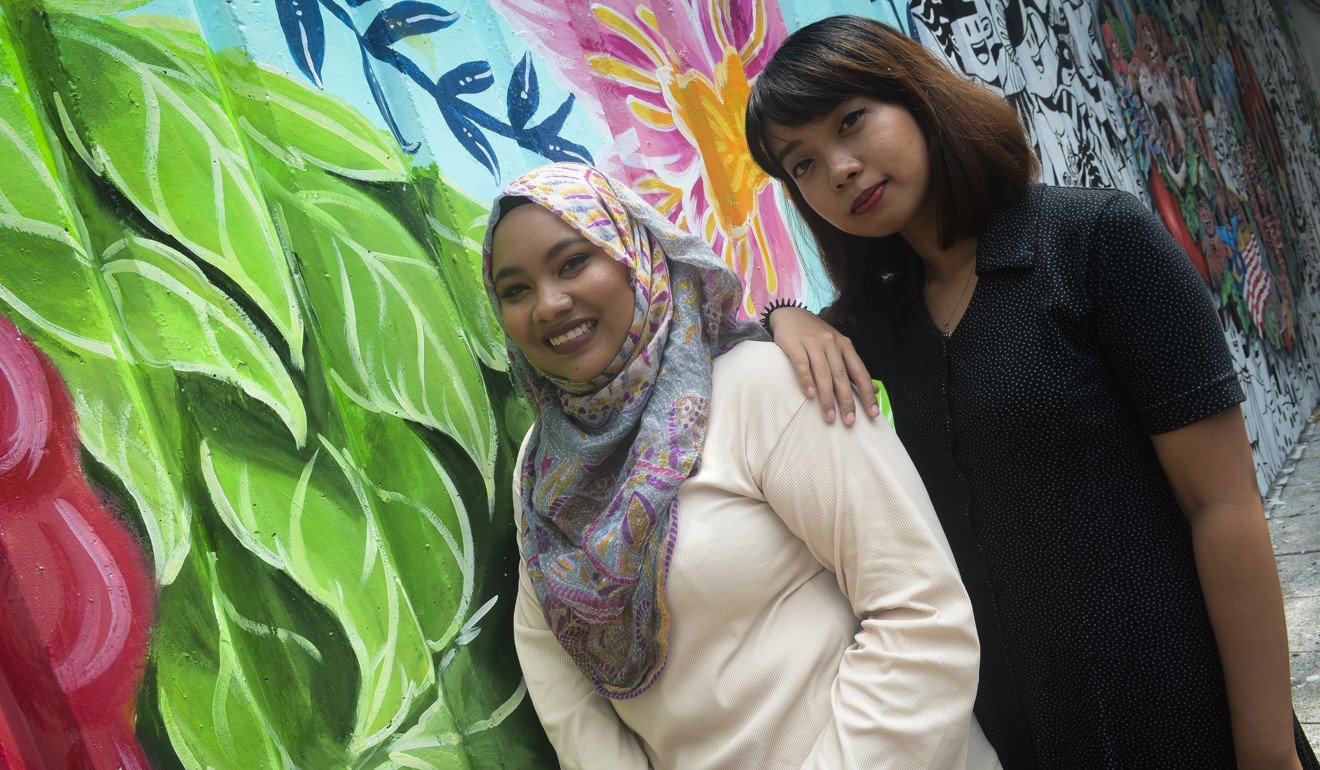
Female street artists in Malaysia use walls to challenge stereotypes and start a conversation about diversity and gender roles
- On the streets of Kuala Lumpur, Malaysian women are using public art to express their feelings about issues such as female empowerment
- They talk about reactions to their work, taking it to the next level, and the transience of outdoor art

When Yante Ismail was painting a mural on a concrete wall facing an alley in Bangsar, a trendy Kuala Lumpur suburb, she had many passers-by asking her about her view. Her piece, entitled Keep Your Laws Off My Body, depicted a defiant, curvy woman with flying, flaming red hair.
Taking art outdoors opens it up to public scrutiny, and Yante says she had to reassure curious onlookers that she was not promoting anarchy, but rejecting confined parameters and gender roles for women. “I don’t do art just for the sole purpose of provoking. I want to encourage thinking and discourse,” she says.
When some young men chided her for not making the woman in the painting thinner, however, she could not help but give them an earful.
Yante, 45, is one of a wave of female street artists and muralists who are painting in Malaysia’s public spaces to express their opinions in a riot of colours. The overarching theme of her artwork is women’s empowerment, inspired in part by her work in a humanitarian agency.

Yante painted Keep Your Laws Off My Body on the Wall of Voice outside the 27Telawi art gallery in March. The wall is an initiative encouraging female artists to start conversations about the influences behind their work. The laws she refers to are man-made, and dictate how a woman should live, look, dress and act.
“I was just challenging that, in reclaiming a woman’s body as her own,” she says. “She owns her body and, therefore, she has the agency to dictate how she wants to live her life.”

This was her first time painting in public, and she hopes it offers an alternative narrative to young women, especially those who cannot afford to buy art.
“I’m used to my art being permanent. And now I’m confronted by its transience, the impermanence of this piece.” The painting took two days to complete, but within a month, after the Women’s Day celebrations, it was painted over by another artist.
Yante is not alone. Inspired by Malaysia’s rich textile heritage, mural artists Nor Asyikin Abdullah and Nurul Afiqah Mohd Nor explore the idea of unity in the multicultural influences found in fabric and design, from Malay batik, to Indian mandalas and Chinese chrysanthemums.
I don’t do art just for the sole purpose of provoking. I want to encourage thinking and discourse
They took part in a competition on the theme of “Love, Respect and Unity” to mark International Women’s Month in March. Instead of exhibiting the typical two-dimensional skin-tone depictions of the country’s three major races, the girls decided to paint them in shades of red, yellow, purple and blue.
“Instead of the usual muhibah (goodwill) portrayal that we are used to, we wanted to show real diversity that goes beyond skin tones,” says Nor, 28, who works as a lawyer.
Despite the challenges of the tropical weather, over four days and nights the pair completed a mural 10 feet by 20 feet (3 metres by 6 metres) mural along busy Jalan Raja Chulan in central Kuala Lumpur. It won third place.
Full-time muralist Nurul, 30, says they have both been painting murals for four years and love the scale that large outdoor projects offer. “It’s bigger, brighter and closer to people, offering positive energy and insight.”

After spending 20 years working in media, Nini Marini, 42, now illustrates and paints, and experiments with technology. She is an aspiring pattern designer with a penchant for fabric design. She likes transforming large spaces with her paintings, which range from the abstract to illustrative floral designs.
Early this year she spent three days covering 300 sq ft of a client’s office wall with swirls of blue and yellow, inviting the sea into the room. While it was her second office mural commission, it was her first freestyle attempt at painting an abstract piece.
Nini’s first large-scale mural commission was in 2012. It was a live community painting project at a Levi’s pop-up store at Pavilion KL, a shopping centre. Together with volunteers invited through social media, she painted on a 13-foot by 11-foot canvas. She portrayed a woman’s will to rise above herself.

When we meet, Nini is preparing her next piece, Essence. It will look different when flipped vertically or horizontally because she has worked on it from all sides.
Nini thinks Malaysian street artists have yet to find their identity. “We haven’t reached that level where it is intelligent,” she says. Artists are still mimicking others, experimenting.
“It is not at the stage yet where they are painting and engaging with the environment around them,” she says.
She sees women artists thriving through collaborations with people outside their own art circles. Textile designer and weaver Shan Shan Lim, for example, and a group of eight female artists with a common goal to be heard produced an exhibition called “I RISE”.
“I think it’s important to support each other and create new stories for yourself as an individual and an artist,” Nini says. “There needs to be more creativity in how we fund art in this country, with more support, too, for women artists who have families but are in need of expressing themselves creatively.”